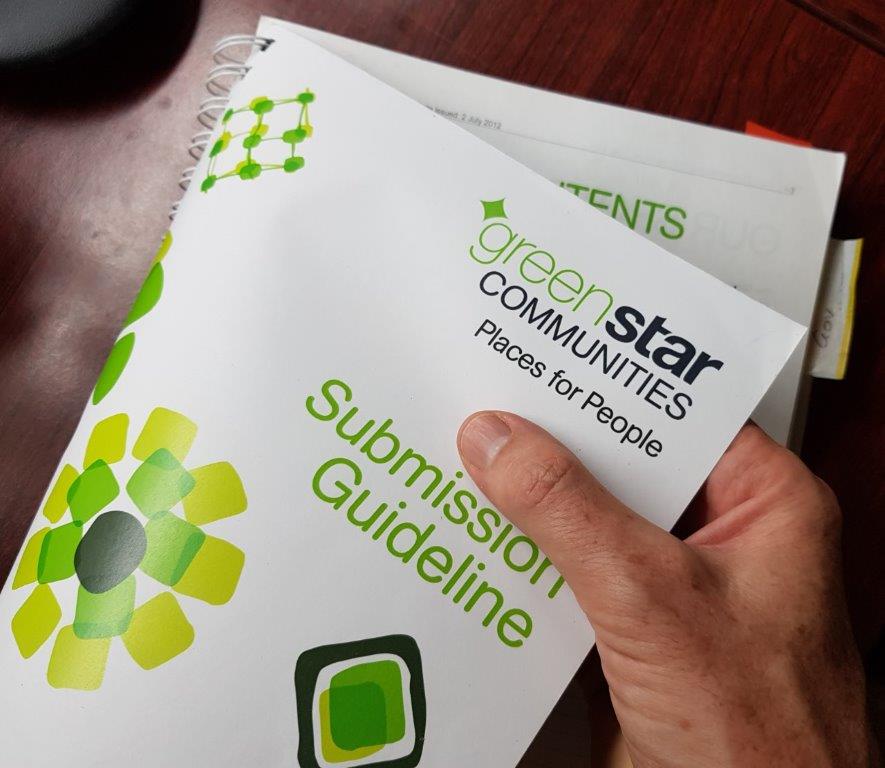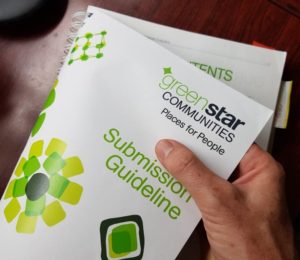“Green Star – Communities” is Australia’s most recognised sustainability rating tool for neighbourhoods and precincts.
To obtain a rating for a project, evidence must be submitted demonstrating that the project has been designed to be very sustainable. Preparing a submission can take many hours over a few months; however, there are steps you can take to make that much easier.
Re-certification can also be a tedious process if you don’t start early.
As an independent private Assessor for the Green Building Council of Australia, I review project multiple submissions each year. Several of them have struggled to specifically address some of the credit criteria and do not get credit were they could have.
To make it easier for everyone to plan for or attempt a Green Star Communities rating, I have listed my top 10 tips for making Green Star easy. I hope this helps. Remember that if you need a hand with evaluating green rating tool benefits or preparing a submission, feel free to contact Ecomplish:
1.Start with a sustainability strategy and plan and design holistically: Green Star shouldn’t be used first, as it is a rating tool which rewards best-practice, not a design methodology. So, start with the site and the audience in mind and aim high. Create a Vision, then Principles to support that. Then document the strategy and an action plan to ensure the vision will be achieved. Then, if the project has achieved some best-practices and you can list evidence about them, a Green Star rating will come very easily. For example, if recycling water makes sense across the precinct because water is scarce, and it will be cost effective etc, then plan for that early on and show it in the design. Avoid leaving this too late and ensure the metrics demonstrate how much potable water it will save. Similarly, if you think residents will value a centralised garden, put that in a central location and claim the ‘Local Food Production’ credit point, rather than trying to retrofit it in a poor location years down the track.
2. Start early: By planning early, you can ensure your sustainability strategy will be considered from feasibility to design through to construction and operation. Preferably start this before the site is purchased or at least at concept planning stage. Too many people try to attempt a rating after the Development Application (Permit) has been submitted. This means if the tool reminds the project to consider smarter methods or design innovations, it is too late to update the overall design. For example, if you haven’t arranged for three independent qualified town planners/urban designers to review your site, layout and urban design and incorporated their feedback, then you’ll miss out on some great advice and improvement opportunities, and miss out on being able to claim 8 points in the Green Star Communities design review category, and that is a lot of points! I have seen multiple projects where the review workshops are started too late in the design process or use unqualified people.
3.Experience Counts: Have someone with previous Green Star Communities submission experience on the team. Having a Green Star Accredited Professional (GSAP) is helpful, but many GSAPs do not have Green Star Communities experience or documentation preparation experience. Using someone with substantial experience with the tool will save your project many hours (I estimate savings of 30% to 60%, which could equate to $30,000 to $60,000 and other benefits such as tailored innovations). Green Star submission administration can take a long time, especially if you don’t know the tricks of the trade. Such people also often come with a wealth of sustainable design experience and are well connected, so they can help the project in multiple ways. Having a GSAP on the team and coordinating Green Star before the planning or design starts will also ensure you can achieve the first point in the rating tool.
4. Submit Smart: only submit what the Guidelines require. If you submit hundreds of pages of documentation it makes it harder to find the exact part that will achieve the credit, and it annoys the Assessor. At the start and end of a drafting a submission, go to the Documentation Requirements of the credits you are targeting, and ensure you’ve documented that.
5. Queries: if you are not sure about something ask another GSAP or the GBCA. They are there to help. They may recommend submitting a Credit Interpretation Request (CIR) which can then be reviewed in advance of your submission being assessed. If it is approved, you already know it is likely that the Assessor will be able to approve it too. In other words, don’t submit proposals or suggest alternative methods in your submission, as the Assessors can only use the Guidelines (rules) to assess your evidence. If you cannot meet the Guidelines but believe you can meet the intent of a credit a different way, then get that confirmed by the GBCA early on and it will save you a lot of time and reduce the unknowns.
6. Use experienced sustainability consultants to suggest innovations appropriate for your project. If they are unique, they are more likely to be approved. There are 10 Innovation points permitted under the system so there is no reason why your project shouldn’t be able to obtain many of these points, which will reduce the pressure for the project to achieve other (perhaps harder) credit criteria. Also check to ensure your idea is new to Australia or the world. If you can find other instances of it already in place then the Assessor won’t be able to award the point(s) for it and you would have wasted time generating the evidence for the claim.
7. Evaluate credit options constantly. Use a tool to track each and compare them: Once you have completed your draft concept, list all the credit you think it could achieve. Rule out harder ones. Estimate the costs and benefits of each initiative and then you will have a better idea of which ones would be better for your project to target. Remember however that Green Star is not a decision making or planning too, so always keep the vision and principles of your project at the fore.
8. Make the submission easy to assess. By completing the submission template fully and highlighting the exact text in the evidence that shows the criteria is met, you will be showing yourself and the assessor you know the points should be awarded for that credit. If you make the assessor’s task more difficult by putting in superfluous documentation or not providing exactly what the Documentation Requirements need, then they will need to scrutinise each credit even more thoroughly. Poor credit documentation also means they will have to review all the credits, rather than use the staged approach where only some credits are reviewed. The staged approach means that, if the first 20 or so of credit documentation is near perfect, then the other credit documentation may be only skimmed, and the rating achieved (and much more quickly and easily).
9. Document management: set up an electronic documentation repository that can be accessed by all design team members. Also add an area where any team member or consultant/contractor can add evidence any time. This might be a shared Dropbox, OneDrive or GoogleDrive. Create folders for each credit and place an index at the top. Also create and keep a Green Star tracker spreadsheet in this folder, with the constant status of each credit e.g. 60% chance of achieving 19.2 Skills Development Programs, through X. Naturally, plan regularly monthly meetings to recap on where each credit is at. In between meetings, the GSAP should be ensuring all people with the task to achieve particular credits are also preparing the evidence for the submission as they go, in the right format.
10. Learn from other projects: have a look at the numerous existing Green Star Communities and learn from their lessons. Did their centralised battery storage system work? Are their residents using the car spaces at the community centre or would that money have been better spent elsewhere? How did they approach rain water collection? Some of this information is available publically and it is a shame to waste such valuable experience. After all, they may have already copied ideas you had on your last project too. Indeed, we can only move forward as industry leaders if we keep aiming to outperform, for the benefit of the residents who will live in our leading sustainable communities.
For more advice or assistance, feel free to call us any time.


